
Arrhenatherum elatius is a species of flowering plant in the grass family Poaceae, commonly known as bulbous oat grass, false oat-grass, tall oat-grass, tall meadow oat, onion couch and tuber oat-grass. It is native to Europe, western Asia, and northern Africa. This bunchgrass is often used as an ornamental grass and is sometimes marketed as "cat grass".

Dalea foliosa, commonly called leafy prairie clover, is a species of flowering plant in the legume family (Fabaceae). It is an endangered species in the United States, where it occurs in three states: Illinois, Tennessee, and Alabama.
Pseudobahia bahiifolia is a rare species of flowering plant in the family Asteraceae known by the common name Hartweg's golden sunburst.
Ambrosia cheiranthifolia is a rare species of flowering plant known by the common names South Texas ambrosia and Rio Grande ragweed. It is native to the coast of South Texas and the Mexican states of Tamaulipas and Coahuila. It occurs in coastal prairie, grassland, and mesquite shrubland habitat. It has declined because its native habitat has been cleared for development, with remaining open savanna invaded by non-native grasses such as buffelgrass. Today there are perhaps 20 populations remaining, but some of these may have very few genetic individuals because the species is clonal, with many cloned plants attached by one rhizome. It is not certain that the plant still exists in Mexico. This is a federally listed endangered species of the United States.

Chrysopsis floridana is a rare species of flowering plant in the family Asteraceae, known by its common name, Florida golden aster. It is endemic to Florida in the United States, where it is known from Hillsborough, Hardee, Manatee, and Pinellas Counties. It is considered an endemic of the west-central coast of the state in the general vicinity of Tampa Bay. There are 17 to 20 occurrences, many of which have few individuals, but one of which has over one million plants. In 1986 the plant was added to the US endangered species list because it was becoming increasingly rare, it was growing only on private property, and its habitat was unprotected and being destroyed and degraded by a number of forces. It is found at Bell Creek Nature Preserve in Riverview, Florida.

Dicerandra frutescens is a rare species of flowering plant in the mint family known by the common names scrub mint and scrub balm. It is endemic to Highlands County, Florida, where it is known only from the Lake Wales Ridge. Its habitat is quickly being lost as it is converted to residential and agricultural use. It was federally listed as an endangered species of the United States in 1985.
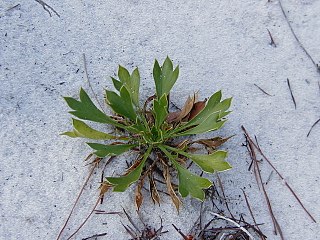
Eryngium cuneifolium is a rare species of flowering plant in the carrot family known by the common names wedgeleaf eryngo, wedge-leaved button-snakeroot, and simply snakeroot. It is endemic to the state of Florida in the United States where it is known only from Highlands County. It is one of many rare species that can be found only on the Lake Wales Ridge, an area of high endemism. It was federally listed as an endangered species of the United States in 1987.
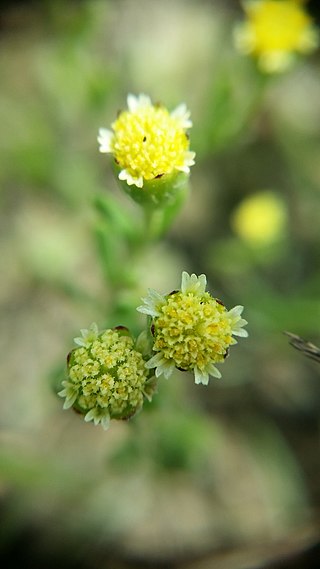
Hymenoxys texana is a rare species of flowering plant in the aster family known by the common names prairie dawn, Texas prairie dawn-flower, and Texas bitterweed. It is endemic to Texas, where it is known only from the general vicinity of Houston. It is threatened by the loss of its habitat. It is a federally listed endangered species of the United States.

Lespedeza leptostachya is a rare species of flowering plant in the legume family known by the common names prairie lespedeza and prairie bush-clover. It occurs in the Upper Midwest region of the United States. The flowers are creamy-white to purplish and arranged into a narrow terminal spikes.

Physaria filiformis is a rare species of flowering plant in the family Brassicaceae known by the common names Missouri bladderpod and limestone glade bladderpod. It is native to Missouri and Arkansas in the United States. It was federally listed as an endangered species in 1987 and it was downlisted to threatened status in 2003. P. filiformis remains listed as an endangered species at the state level in Missouri.

Sidalcea nelsoniana is a rare species of flowering plant in the mallow family known by the common names Nelson's checkerbloom and Nelson's checkermallow. It is native to the Willamette Valley and Coast Range of Oregon and the southwestern corner of Washington in the United States. It is threatened by the destruction and degradation of its habitat, and it is a federally listed threatened species of the United States.

Spigelia gentianoides is a rare species of flowering plant in the Loganiaceae known by the common names purpleflower pinkroot and gentian pinkroot. It is native to Alabama and Florida in the United States, where a few small populations remain. It is threatened by the loss and degradation of its habitat, and is a federally listed endangered species of the United States.

Spiranthes delitescens is a rare species of orchid known by the common names reclusive lady's tresses, Canelo Hills lady's tresses, and Madrean lady's tresses. It is native to Arizona in the United States, where there are only four occurrences. It is threatened by the loss and degradation of its habitat. It is a federally listed endangered species of the United States.
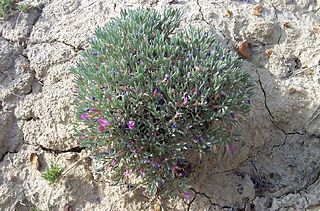
Astragalus barrii is a species of flowering plant in the legume family known by the common name Barr's milkvetch. It is native to the United States, where it is a "regional endemic", occurring in parts of southwestern South Dakota, northeastern Wyoming, southeastern Montana, and Nebraska.
Chloris texensis is a species of grass known by the common name Texas windmill grass. It is endemic to Texas in the United States, where it occurs on the coastal prairies.
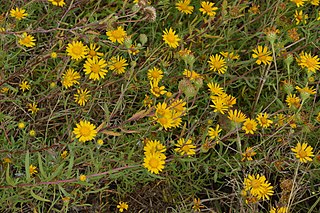
Rayjacksonia aurea is a species of flowering plant in the family Asteraceae known by the common names Houston tansyaster and Houston camphor daisy. It is endemic to Texas in the United States, where it is known only from the Houston area. It is limited to Galveston and Harris Counties.
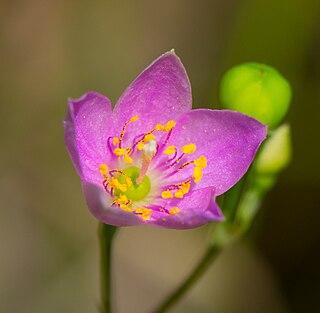
Phemeranthus rugospermus is a species of flowering plant in the miner's lettuce family, Montiaceae, known by the common names prairie fameflower, rough-seeded fameflower, and flower-of-an-hour. It is native to the central United States from Texas and Louisiana north to Nebraska, Minnesota, and Wisconsin.
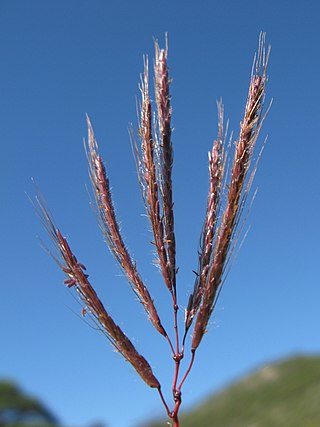
Dichanthium annulatum is a species of grass in the family Poaceae. It is commonly used as a forage for livestock.

Physaria thamnophila is a rare species of flowering plant in the mustard family known by the common name Zapata bladderpod. It is native to Texas in the United States, where it is known from Zapata and Starr Counties. The plant is threatened by the loss and degradation of its habitat. It is federally listed as an endangered species.

Lespedeza virginica, known as slender bush clover or slender lespedeza, is a species of flowering plant native to much of the United States, as well as Ontario, Canada, and Nuevo León, Mexico. It is a member of the bean family, Fabaceae.



















